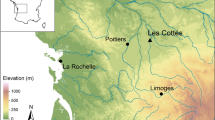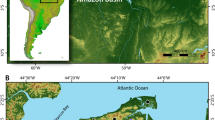Abstract
Since its introduction in 19771, stable isotope analysis of bone collagen has been widely used to reconstruct aspects of prehistoric human and animal diets2–11. This method of dietary analysis is based on two well-established observations, and on an assumption that has never been tested. The first observation is that bone collagen 13C/12C and 15N/14N ratios reflect the corresponding isotope ratio of an animal's diet1–5,12. The second is that groups of foods have characteristically different 13C/12C and/or 15N/14N ratios13,14. Taken together, the two observations indicate that the isotope ratios of collagen in the bones of a living animal reflect the amounts of these groups of foods that the animal ate. Thus, it has been possible to use fresh bone collagen 13C/12C ratios to determine the relative consumption of C3 and C4 plants15–17, while 13C/12C and 15N/14N ratios have been used to distinguish between the use of marine and terrestrial foods14. The 15N/14N ratios of fresh bone collagen probably also reflect the use of leguminous and non-leguminous plants as food5, but this has not yet been demonstrated. Prehistoric consumption of these same groups of foods has been reconstructed from isotope ratios of collagen extracted from fossil bone1–11. Implicit in the application of the isotopic method to prehistoric material is the assumption that bone collagen isotope ratios have not been modified by postmortem processes. Here I present the first examination of the validity of this assumption. The results show that postmortem alteration of bone collagen isotope ratios does occur, but that it is possible to identify prehistoric bones whose collagen has not undergone such alteration.
This is a preview of subscription content, access via your institution
Access options
Access to this article via Institution of Civil Engineers Library is not available.
Subscribe to this journal
Receive 51 print issues and online access
$199.00 per year
only $3.90 per issue
Buy this article
- Purchase on SpringerLink
- Instant access to full article PDF
Prices may be subject to local taxes which are calculated during checkout
Similar content being viewed by others
References
van der Merwe, N. J. & Vogel, J. C. Am. Antiq. 42, 238–242 (1977).
van der Merwe, N. J. & Vogel, J. C. Nature 276, 815–816 (1978).
Burleigh, R. & Brothwell, D. J. archaeol. Sci. 5, 355–362 (1978).
Bender, M. M., Baerris, D. A. & Steventon, R. L. Am. Antiq. 46, 346–353 (1981).
DeNiro, M. J. & Epstein, S. Geochim. cosmochim. Acta 45, 341–351 (1981).
Tauber, H. Nature 292, 332–333 (1981).
Chisholm, B. S., Nelson, D. E. & Schwarcz, H. P. Science 216, 1131–1132 (1982).
Chisholm, B. S., Nelson, D. E. & Schwarcz, H. P. Curr. Anthrop. 24, 396–398 (1983).
Hobson, K. A. & Collier, S. Curr. Anthrop. 25, 238–240 (1984).
Boutton, T. W., Klein, P. D., Lynott, M. J., Price, J. E. & Tieszen, L. L. Am. chem. Soc. Symp. 258, 191–204 (1984).
Schoeninger, M. J., DeNiro, M. J. & Tauber, H. Science 220, 1381–1383 (1983).
DeNiro, M. J. & Epstein, S. Geochim. cosmochim. Acta 42, 495–506 (1978).
Deines, P. in Handbook of Environmental Isotope Geochemistry Vol. 1 (eds Fritz, P. & Fontes, J. Ch.) 329–406 (Elsevier, London, 1980).
Schoeninger, M. J. & DeNiro, M. J. Geochim. cosmochim. Acta 48, 625–639 (1984).
DeNiro, M. J. & Epstein, S. Science 201, 906–908 (1978).
Vogel, J. C. S. Afr. J. Sci. 74, 298–301 (1978).
Land, L. S., Lundelius, E. L. & Valastro, S. Palaeogeogr. Palaeoclimatol., Palaeoecol. 32, 143–151 (1980).
DeNiro, M. J. & Schoeninger, M. J. J. archaeol. Sci. 10, 199–203 (1983).
DeNiro, M. J., Schoeninger, M. J. & Hastorf, C. A. J. archaeol. Sci. 12, 1–7 (1985).
DeNiro, M. J. & Epstein, S. Geochim. cosmochim. Acta (in the press).
Walker, E. P. Mammals of the World (Johns Hopkins University Press, Baltimore, 1974).
Author information
Authors and Affiliations
Rights and permissions
About this article
Cite this article
DeNiro, M. Postmortem preservation and alteration of in vivo bone collagen isotope ratios in relation to palaeodietary reconstruction. Nature 317, 806–809 (1985). https://doi.org/10.1038/317806a0
Received:
Accepted:
Published:
Issue Date:
DOI: https://doi.org/10.1038/317806a0



